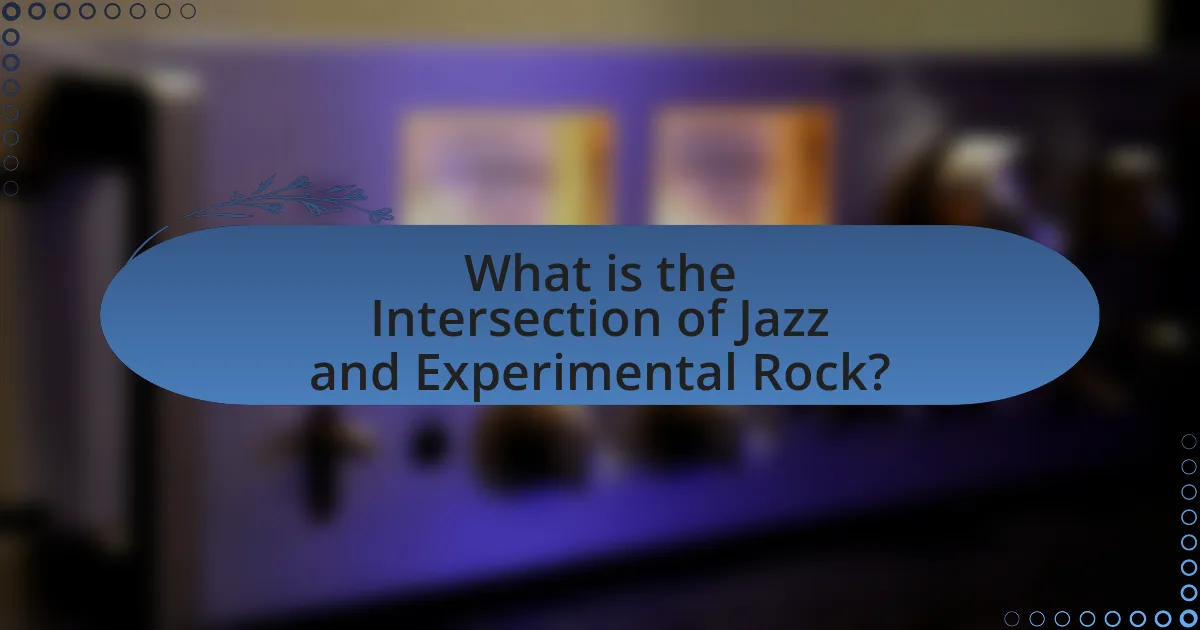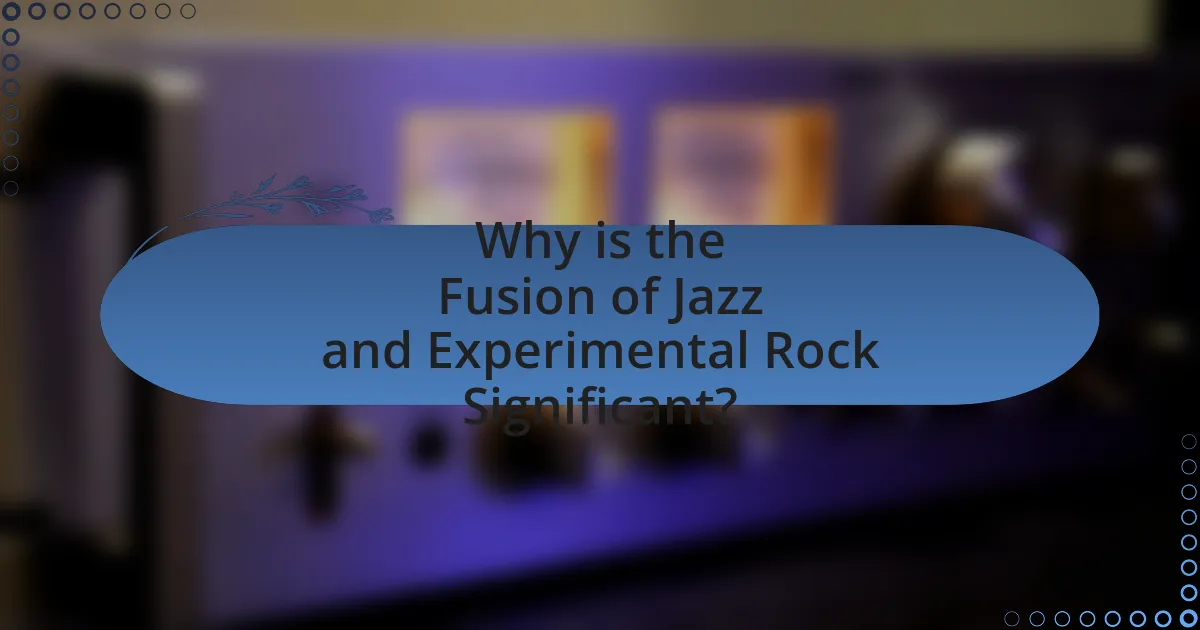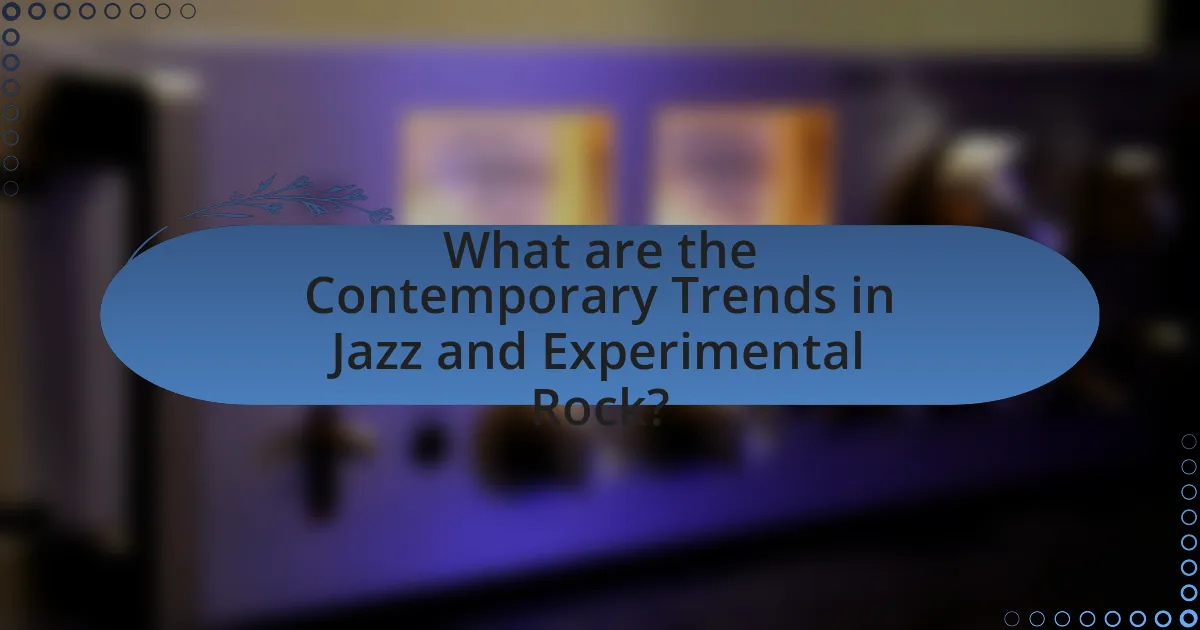The article explores the intersection of jazz and experimental rock, highlighting how these genres blend improvisational elements, complex rhythms, and innovative structures. It examines the influence of jazz on the development of experimental rock, detailing key characteristics such as improvisation, harmonic experimentation, and the use of unconventional instrumentation. The piece also discusses notable collaborations, significant albums, and contemporary trends, emphasizing the cultural movements and technological advancements that have shaped this fusion. Additionally, it addresses the challenges and opportunities faced by artists in these genres, providing insights for listeners interested in exploring this dynamic musical landscape.

What is the Intersection of Jazz and Experimental Rock?
The intersection of jazz and experimental rock is characterized by the blending of improvisational elements and complex rhythms from jazz with the innovative structures and sonic experimentation found in experimental rock. This fusion often results in music that challenges traditional genre boundaries, as seen in the works of artists like Frank Zappa and the band King Crimson, who incorporated jazz harmonies and improvisation into their rock compositions. The collaboration between musicians from both genres has led to the creation of unique soundscapes that emphasize creativity and spontaneity, reflecting a shared ethos of exploration and artistic freedom.
How did Jazz influence the development of Experimental Rock?
Jazz significantly influenced the development of Experimental Rock by introducing complex rhythms, improvisation, and innovative harmonic structures. Artists in the Experimental Rock genre, such as Frank Zappa and the band King Crimson, incorporated jazz elements to create a more avant-garde sound. The use of extended instrumental solos and unconventional time signatures, hallmarks of jazz, became prevalent in Experimental Rock, allowing musicians to explore new sonic territories. This fusion is evident in albums like “In the Court of the Crimson King,” which showcases jazz-inspired improvisation alongside rock elements, demonstrating the direct impact of jazz on the evolution of this genre.
What key elements of Jazz are incorporated into Experimental Rock?
Key elements of Jazz incorporated into Experimental Rock include improvisation, complex rhythms, and harmonic experimentation. Improvisation allows musicians to create spontaneous melodies and solos, which is a hallmark of both genres. Complex rhythms, often derived from jazz’s syncopation and polyrhythms, contribute to the dynamic and unpredictable nature of Experimental Rock. Additionally, harmonic experimentation, characterized by the use of extended chords and unconventional progressions, enhances the sonic palette of Experimental Rock, drawing directly from jazz influences. These elements are evident in the works of artists like Frank Zappa and the band King Crimson, who blend jazz techniques with rock structures to create innovative soundscapes.
How do improvisation and spontaneity play a role in both genres?
Improvisation and spontaneity are central to both jazz and experimental rock, as they allow musicians to create unique and dynamic performances in real-time. In jazz, improvisation is a foundational element, enabling artists to express individual creativity and respond to fellow musicians, often resulting in unexpected musical developments. Similarly, experimental rock embraces spontaneity, encouraging artists to explore unconventional sounds and structures, often leading to innovative compositions that defy traditional genre boundaries. The fluid nature of both genres fosters an environment where musicians can take risks, leading to fresh and engaging experiences for audiences.
What are the defining characteristics of Jazz and Experimental Rock?
Jazz is characterized by its improvisational nature, complex harmonies, and syncopated rhythms, while Experimental Rock is defined by its innovative structures, incorporation of diverse genres, and use of unconventional instruments and techniques. Jazz often features instruments like the saxophone, trumpet, and piano, emphasizing spontaneous creativity, as seen in the works of artists like Miles Davis and John Coltrane. In contrast, Experimental Rock, exemplified by bands like Pink Floyd and Radiohead, pushes boundaries through non-traditional song forms, electronic elements, and thematic exploration, often challenging the listener’s expectations. Both genres share a commitment to artistic expression and exploration, making them influential in the evolution of modern music.
How do rhythm and harmony differ between Jazz and Experimental Rock?
Rhythm and harmony in Jazz and Experimental Rock differ significantly in structure and execution. Jazz typically employs complex rhythms, often featuring syncopation and swing, alongside rich harmonic progressions that utilize extended chords and improvisation. In contrast, Experimental Rock tends to favor more straightforward, sometimes repetitive rhythms, and may incorporate unconventional harmonies, often eschewing traditional chord progressions in favor of dissonance and modal experimentation. This distinction is evident in the works of artists like Miles Davis in Jazz, who utilized intricate rhythmic patterns and harmonic sophistication, compared to bands like Radiohead in Experimental Rock, which often explore minimalist rhythms and abstract harmonic structures.
What instrumentation is commonly used in both genres?
Both jazz and experimental rock commonly utilize instruments such as the saxophone, electric guitar, and drums. The saxophone serves as a prominent melodic instrument in jazz, while in experimental rock, it adds unique textures and improvisational elements. The electric guitar is central to both genres, providing harmonic support and allowing for innovative sound manipulation. Drums are essential in both styles, driving rhythm and enabling complex time signatures. These instruments facilitate the improvisational and exploratory nature characteristic of both jazz and experimental rock, highlighting their shared musical language.

Why is the Fusion of Jazz and Experimental Rock Significant?
The fusion of jazz and experimental rock is significant because it creates a unique musical landscape that encourages innovation and improvisation. This combination allows artists to explore complex rhythms, harmonies, and structures, pushing the boundaries of both genres. For instance, bands like King Crimson and the Mahavishnu Orchestra have successfully integrated jazz elements into rock, resulting in groundbreaking works that have influenced countless musicians. The blending of these styles not only enriches the listening experience but also fosters a collaborative spirit among artists, leading to the evolution of new subgenres and musical techniques.
What cultural movements have influenced the fusion of these genres?
The cultural movements that have influenced the fusion of jazz and experimental rock include the Beat Generation and the counterculture of the 1960s. The Beat Generation, characterized by its rejection of conventional norms and exploration of new artistic expressions, laid the groundwork for musicians to experiment with form and content, leading to innovative blends of jazz improvisation with rock structures. The 1960s counterculture further propelled this fusion by embracing eclecticism, promoting artistic freedom, and encouraging the exploration of new sounds, as seen in the works of artists like Frank Zappa and Miles Davis, who incorporated rock elements into jazz compositions. This cultural backdrop facilitated a creative environment where genre boundaries were blurred, resulting in a rich tapestry of musical experimentation.
How did the counterculture of the 1960s impact Jazz and Experimental Rock?
The counterculture of the 1960s significantly influenced Jazz and Experimental Rock by promoting artistic freedom and innovation. This era saw musicians embracing new forms of expression, leading to the fusion of genres and the incorporation of unconventional sounds and techniques. For instance, artists like Miles Davis began to experiment with modal jazz and electronic instruments, reflecting the counterculture’s emphasis on breaking traditional boundaries. Similarly, bands such as The Velvet Underground and Frank Zappa’s Mothers of Invention blended rock with avant-garde elements, showcasing the era’s spirit of rebellion and exploration. This cross-pollination of styles not only expanded the musical landscape but also encouraged a generation of artists to challenge societal norms through their work.
What role did technology play in the evolution of these genres?
Technology significantly influenced the evolution of jazz and experimental rock by enabling new sounds and innovative techniques. The introduction of electric instruments, such as the electric guitar and synthesizers, allowed musicians to explore a broader sonic palette, leading to the fusion of jazz improvisation with rock’s rhythmic intensity. Additionally, advancements in recording technology, including multi-track recording and digital editing, facilitated complex arrangements and the layering of sounds, which became hallmarks of both genres. For instance, the use of tape loops and effects pedals in the 1960s and 1970s allowed artists like Miles Davis and Frank Zappa to experiment with sound manipulation, further blurring the lines between jazz and rock. These technological developments not only expanded the creative possibilities for musicians but also transformed the listening experience for audiences, making it more immersive and dynamic.
What are some notable collaborations between Jazz and Experimental Rock artists?
Notable collaborations between Jazz and Experimental Rock artists include the partnership between Miles Davis and the band Weather Report, which blended jazz fusion with rock elements. Another significant collaboration is between John Zorn and the band Naked City, where Zorn’s avant-garde jazz influences merged with rock sensibilities. Additionally, the collaboration of guitarist Bill Frisell with various rock musicians, such as his work with the band The Bad Plus, showcases the intersection of these genres. These collaborations highlight the innovative fusion of jazz improvisation and experimental rock’s boundary-pushing sound.
Which albums exemplify the fusion of Jazz and Experimental Rock?
Albums that exemplify the fusion of Jazz and Experimental Rock include “Bitches Brew” by Miles Davis, “The Black Saint and the Sinner Lady” by Charles Mingus, and “In a Silent Way” by Miles Davis. “Bitches Brew,” released in 1970, is often credited with pioneering jazz fusion, blending electric instruments and rock rhythms with jazz improvisation. “The Black Saint and the Sinner Lady,” released in 1963, showcases complex arrangements and innovative structures that influenced both jazz and rock musicians. “In a Silent Way,” released in 1969, features a seamless blend of jazz and rock elements, emphasizing atmosphere and texture. These albums are significant for their groundbreaking approaches and lasting impact on both genres.
How have these collaborations shaped the music landscape?
Collaborations between jazz and experimental rock musicians have significantly shaped the music landscape by fostering innovation and blending genres. These partnerships have led to the creation of unique soundscapes that challenge traditional musical boundaries, as evidenced by the work of artists like Miles Davis and the band Pink Floyd, who incorporated improvisational elements and complex structures into their music. The fusion of jazz’s spontaneity with the experimental nature of rock has resulted in influential albums such as “Bitches Brew,” which not only expanded the audience for both genres but also inspired countless musicians across various styles. This cross-pollination has ultimately enriched the music industry, encouraging a culture of experimentation and collaboration that continues to thrive today.

What are the Contemporary Trends in Jazz and Experimental Rock?
Contemporary trends in jazz and experimental rock include the fusion of genres, increased use of technology, and a focus on improvisation and collaboration. Artists are blending traditional jazz elements with rock structures, creating innovative soundscapes that challenge conventional boundaries. For instance, musicians like Kamasi Washington and the band Snarky Puppy exemplify this trend by incorporating diverse influences and complex arrangements. Additionally, the use of electronic instruments and production techniques has become prevalent, allowing for new textures and sonic possibilities. This evolution reflects a broader cultural shift towards genre fluidity and experimentation in music.
How are modern artists blending Jazz and Experimental Rock today?
Modern artists are blending Jazz and Experimental Rock by incorporating improvisational techniques, complex rhythms, and diverse instrumentation from both genres. This fusion is evident in the works of artists like Kamasi Washington, who combines jazz saxophone with rock elements, and bands such as The Comet is Coming, which merges electronic sounds with jazz improvisation and rock energy. The use of unconventional song structures and a focus on live performance improvisation further exemplifies this blend, allowing for a dynamic and evolving musical experience that reflects the innovative spirit of both genres.
What new techniques and styles are emerging in this fusion?
New techniques and styles emerging in the fusion of jazz and experimental rock include the use of polyrhythms, extended improvisation, and electronic instrumentation. Polyrhythms allow musicians to create complex rhythmic structures that enhance the dynamic interplay between jazz’s swing and rock’s drive. Extended improvisation, a hallmark of both genres, encourages musicians to explore spontaneous creativity, leading to unique soundscapes. Additionally, the incorporation of electronic instruments, such as synthesizers and effects pedals, expands the sonic palette, enabling artists to blend traditional jazz elements with avant-garde rock influences. These developments reflect a growing trend towards innovation and experimentation within this musical intersection.
How are audiences responding to contemporary Jazz and Experimental Rock?
Audiences are increasingly embracing contemporary Jazz and Experimental Rock, as evidenced by the growing attendance at live performances and the rise in streaming numbers for artists in these genres. This trend reflects a broader cultural shift towards genre-blending music, where listeners appreciate the innovative and improvisational elements characteristic of both styles. For instance, data from the Nielsen Music report indicates a significant increase in streaming of Jazz and Experimental Rock tracks, highlighting a 30% growth in listener engagement over the past year. Additionally, festivals that feature both genres, such as the Newport Jazz Festival, have reported record attendance, showcasing the audience’s enthusiasm for diverse musical experiences.
What can listeners expect from the future of Jazz and Experimental Rock?
Listeners can expect a fusion of innovative sounds and diverse influences in the future of Jazz and Experimental Rock. This evolution will likely incorporate elements from electronic music, hip-hop, and world music, reflecting the genre’s adaptability and the artists’ willingness to experiment. For instance, artists like Kamasi Washington and bands such as The Comet Is Coming are already blending traditional jazz with modern genres, showcasing the potential for cross-genre collaboration. Additionally, advancements in technology will facilitate new forms of expression, allowing musicians to explore complex compositions and improvisational techniques that challenge conventional boundaries.
What are the potential challenges and opportunities for artists in this genre?
Artists in the genre of jazz and experimental rock face challenges such as the difficulty of blending complex musical structures and improvisation, which can alienate mainstream audiences. Additionally, the niche market for this fusion often limits commercial opportunities and access to funding. However, opportunities exist in the form of a growing interest in genre-blending music, which can attract diverse audiences and foster innovative collaborations. The rise of digital platforms also allows artists to reach wider audiences without traditional gatekeepers, enhancing their visibility and potential for success.
What are some tips for exploring Jazz and Experimental Rock music?
To explore Jazz and Experimental Rock music effectively, start by listening to foundational albums from both genres, such as Miles Davis’s “Bitches Brew” for Jazz and King Crimson’s “In the Court of the Crimson King” for Experimental Rock. These albums showcase key elements and innovations that define each genre. Additionally, attend live performances or festivals that feature both styles, as experiencing the music in a live setting can deepen your understanding of improvisation and experimentation. Engaging with online communities or forums dedicated to these genres can also provide insights and recommendations from fellow enthusiasts. Lastly, consider reading literature on the history and evolution of Jazz and Experimental Rock, as understanding the context can enhance your appreciation of the music.
How can listeners identify key tracks and artists in this fusion?
Listeners can identify key tracks and artists in the fusion of jazz and experimental rock by exploring curated playlists, music databases, and genre-specific radio stations. Platforms like Spotify and Apple Music often feature playlists that highlight influential tracks and artists within this fusion, such as Miles Davis and Frank Zappa, who are known for their innovative approaches. Additionally, music databases like Discogs provide comprehensive discographies and user-generated lists that can guide listeners to significant works in this genre. Engaging with music forums and communities, such as those on Reddit or specialized websites, can also help listeners discover essential tracks and artists through discussions and recommendations.
What resources are available for deeper understanding of these genres?
Books, documentaries, and academic journals are essential resources for a deeper understanding of jazz and experimental rock. Notable books include “The Jazz Theory Book” by Mark Levine, which provides foundational knowledge of jazz music theory, and “Experimental Music: Cage and Beyond” by Michael Nyman, which explores the avant-garde aspects of experimental rock. Documentaries such as “Jazz: A Film by Ken Burns” offer historical context and insights into the evolution of jazz, while “The Velvet Underground: A Documentary” highlights the experimental rock genre’s roots. Academic journals like “Jazz Perspectives” and “Popular Music” publish peer-reviewed articles that analyze the intersection of these genres, providing scholarly insights and research findings.